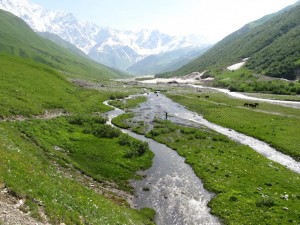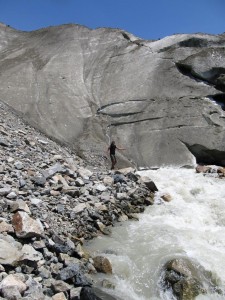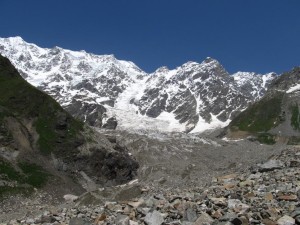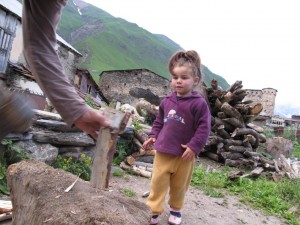When arriving in Ushguli yesterday we were almost immediately certain that the one day we’d planned to stay here would not be enough. We’d need at least one more day to explore the villages and churches that belong to the Ushguli community.
The plan for today was to hike to the foot of Mt Shkhara to have a look at the Shkhara Glacier, which is the source of the Enguri river, which we’d followed since the Ughviri Pass.
We set out at 9.30am and walked through Chvibiani and Zhibiani towards Mt Shkhara, approx. 10km to the northeast. The villages are exceptional; I felt set back to the middle ages. It wasn’t always a pleasant view, of course, but a fascinating one nonetheless. There is some kind of sewage system for the houses, but pigs, sheep, goats, cows and horses use the paths between the houses, including for being fed and milked. Houses and towers are deteriorating. Quite a few are abandoned.
Outside the villages the track went across colorful meadows, was crossed by numerous streams, and blocked by an avalanche. We met a group of four Israeli-Americans and a Canadian on the way.
At the glacier we had a bath in the ice-cold waters of the Enguri directly where it gushes out from under the ice, with rocks falling down from the glacier cliff above every now and then. We explored a cave in the ice, climbed up the glacier and enjoyed the view over the ice masses and toward Mt Shkhara (5068m), which was just a few hundred meters (guesstimated!) away. At that point we were at an elevation of approx. 2600m, just half of that of Mt Shkhara!
Returned the same way we’d come.
The family we’re staying with consists of three generations: grandpa and grandma, both in their 70s, Giorgi and Tiko, in their late 20s/early 30s, and Lika, their three year old daughter.
Walked: 20km







